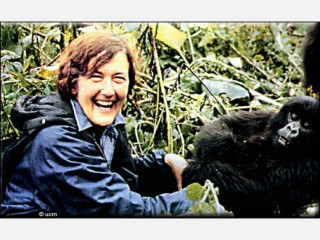
Dian Fossey biography
Date of birth : 1932-01-16
Date of death : 1985-12-24
Birthplace : San Francisco, California, U.S.
Nationality : American
Category : Science and Technology
Last modified : 2011-02-21
Credited as : Zoologist, study of gorilla group,
Dian Fossey was the world's leading authority on the mountain gorilla before her murder, probably at the hands of poachers, in December of 1985.
Dian Fossey's short life was characterized in equal parts by tragedy, controversy, and extraordinary courage and dedication to the animals she made her life work. That dedication drew her back to Africa over and over despite broken bones, failing health, and threats to her life. All and all, she spent 18 years studying the mountain gorillas and working for their survival as a species.
An unlikely chain of circumstances led Fossey to study the mountain gorilla and to her eventual demise high in the fog enshrouded mountains of eastern Africa. Born in San Francisco on January 16, 1932, Fossey was fascinated with animals from an early age. She entered the University of California at Davis to study pre-veterinary medicine but found it difficult to master courses in chemistry and physics. Instead she completed a B.A. in 1954 from San Jose State University in occupational therapy. In 1956 she took a job at Kosair Crippled Children's Hospital in Louisville, Kentucky, where she could pursue her interest in horses during her free time.
In 1963 Fossey obtained a bank loan for $8,000, took a leave from her job as a physical therapist, and went to Africa to seek out paleontologist Louis Leakey, who had mentored Jane Goodall in her pioneering work with chimpanzees. She hoped that Leakey could help her find a job studying gorillas. Later in her life Fossey explained this change in her life course by saying that she felt extraordinarily drawn to Africa and particularly to the mountain gorillas of Rwanda and Zaire (now Congo). This interest was fueled in part by reading the work of George Schaller, who had spent 1959 doing the first comprehensive study of these animals.
Fossey appeared at Leakey's dig site at Olduvai Gorge in Tanzania without an invitation. He mistook her for a tourist and charged a fee to view the excavation. Despite this inauspicious beginning, Fossey clearly made an impression. Nearly six feet tall, with long black hair and a husky voice—the result of chain smoking—she must have been a startling apparition. While walking through the site, she tripped and fell, breaking her ankle and a newly excavated fossil in the process. Leakey's wife Mary bound up her ankle and she proceeded onwards to the mountains of Zaire (now Congo), where she caught her first glimpse of the mountain gorilla.
Her funds exhausted, Fossey returned to Louisville and to her job. In 1966 it was Leakey who sought her out. He wanted her to study the gorillas on a long-term basis and had found a patron who would support the research. Leakey was interested in studies of primates because he believed their behavior would shed light on the behavior of the early hominids whose fossilized bones he was excavating at Olduvai Gorge. He believed that Fossey would be an ideal person to carry out the study because of her intense interest and because he thought that women were more patient and better observers than men and, therefore, made better naturalists.
Fossey accepted Leakey's invitation eagerly. Since she had no formal training she made a brief stop at Jane Goodall's research center at Gombe to learn Goodall's revolutionary methods of fieldwork and data collection. She then proceeded onward to Schaller's old camp in Congo.
The gorillas that Fossey was to study inhabit a narrow strip of forest that covers the sides of several extinct volcanoes on the borders between Rwanda, Congo, and Uganda. Much of their habitat is rain forest at an altitude of 10,000 feet or more. The mountain gorillas can be distinguished from other types of gorillas partly by their adaptions to the climate and altitude: thick coats, broad chests, and large hands and feet. Mature males stand between five and six feet when upright and far outweigh a human being of equivalent size.
Fossey's research in Congo was interrupted July 10, 1967, when she was held for two weeks by soldiers. After escaping from her captors, she relocated to the Rwanda side of the mountains in the Parc National des Vulcans. This would become the Karasoke Research Center where she would carry out her work for the next 17 years.
At Karasoke Fossey studied 51 gorillas in four relatively stable groups. Despite their menacing appearance, Fossey found the gorillas to be quite shy and retiring. She gained their trust through quiet and patient observation and by imitating the gorillas' behavior until she could sit amongst them and could move about or touch the animals without frightening them.
When Fossey first began her research, the number of these gorillas was less than 500 and rapidly diminishing due to the encroachment of farmers and predation from poachers. She was particularly distressed by the practice of killing an entire group of adult gorillas in order to obtain young gorillas to be sold to zoos. In 1978, after the death of Digit, one of her most beloved silverback males, she began taking up unconventional means to protect the gorillas from poachers and from encroaching cattle farmers. She held poachers prisoner, torturing them or frightening them or kidnapping their children, with the idea that this would give them a sense of what gorillas were experiencing at their hands.
On December 24, 1985, Fossey was killed in her cabin at Karasoke, her skull split by a panga, the type of large knife used by poachers. Her murderer has not been identified.
















